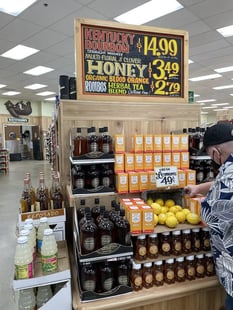Tip #1: Place your most profitable products at eye level
Why it works: Have you heard the phrase “eye level is buy level?” Psychology backs it up. We’re always looking for the easiest and most convenient route — which is why we focus on what’s right in front of us. Having to crouch down or stretch to the top shelves is hard work!
Placing your most popular — and profitable — products at eye level encourages customers to buy.
Related Read: Grocery Store Profit Margins: How To Maximize Profits in Your Store
Tip #2: Design your store layout to create a logical flow
Why it works: Guiding customers through your store helps create a better experience for them. Think about how customers tackle their grocery lists. What should be on the outer perimeter? Can you display all your breakfast items in one place? However you do it, your layout should expose customers to as many products as possible.
Pro tip: Place essentials like milk and bread in the back of your store. It might seem counterintuitive (because you’re making it harder for customers to get what they need), but as they walk through your store, you increase the chance they'll spot something else they "need" along the way.
Tip #3: Make the most of endcaps
Why it works: Endcaps are prime real estate in grocery stores. From cross-selling and encouraging impulse buys to promotions and highlighting new products, endcaps are like an extra salesperson.

Trader Joe’s does this well. Do you want to make a Hot Toddy? Here’s everything you need!
Tip #4: Organize products by color
Why it works: Colors draw people in. They have visual appeal, and organizing your produce by color looks attractive and encourages people to buy more.

Tip #5: Group products together
Why it works: Endcaps aren’t the only place to group products. Placing complementary items near each other encourages impulse buys and reminds customers of things they need. Think chips near dips, salad dressings near lettuce, and baking supplies near flour and sugar.
Tip #6: Make the most of your checkout area
Why it works: The checkout counter is customers’ last stop on their journey through your store, so make the most of it! Stock this area with small, impulse-buy items. Gum, candy bars, small toys for kids — things that are easy to add to a cart at the last minute. They all add up.
Bonus Tip: Use your POS data
Your grocery POS system is a goldmine of data. You can:
- Track which products are often bought together and place them near each other.
- Identify your best-selling items and give them prominent positions.
- Monitor the performance of different store areas and adjust your layout.
Organizing your store is an ongoing process. You can experiment with different layouts and product placements — but you don’t have to guess. Use your POS system to track the results of these changes and refine your approach.
Related Read: How Are Grocery Stores Organized? (+ How You Can Optimize Your Layout)

.webp?width=6000&height=4000&name=Pizza%20display%20case%20(1).webp)

